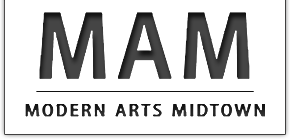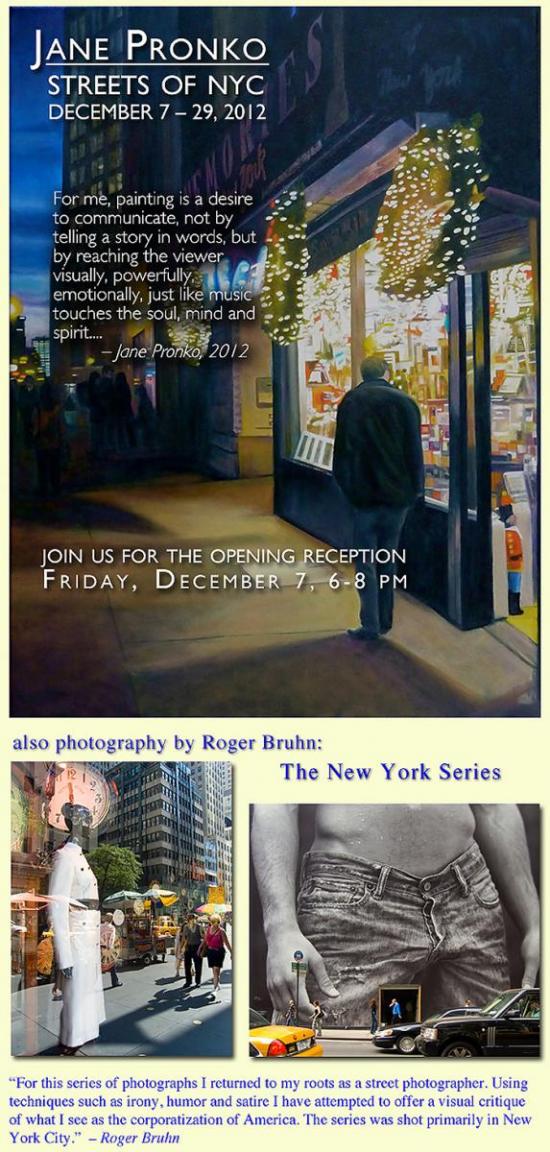The Streets of NYC 12.7.12
-by Michael J. Krainak, Free Lance Writer in the Visual Arts
The Big Apple, Empire City or Gotham.
No matter how you phrase it New York is still the cultural center of the world for artists and their audience. But whether destiny or destination, one’s connection with “the city that never sleeps, might be best expressed in the conflicting tones of Metropolis’ two most famous songs from Broadway and Hollywood. Is New York “a visitor’s place where no one lives on account of the pace” (“On the Town”) or does one succumb to its siren’s pull with “start spreading the news, I’m leaving today. I want to be a part of it,” (“New York, New York”).
This paradox of a big city’s lure is what motivated Larry Roots, artist and owner of Modern Arts Midtown to curate the venue’s current show, Streets of NYC. The exhibit features oil paintings from Kansas City artist Jane Pronko and photography by Lincolnite Roger Bruhn. But while their work shares a similar palette and locale, each caters to the above in an individual style and point of view. Nevertheless, Roots believes the Streets of NYC, location and exhibit, share a vital common ground.
“Everybody loves New York,” he said. “It’s the mystique that binds them. Every artist has a goal of being there and taking advantage of the standard it sets. You go with a belief or perception and it lives up to that mystique as the cradle of all that’s cultural. It’s one of the few places that does.”
Originally from East St. Louis, Illinois, Pronko is a veteran artist in Kansas City whose paintings and prints have been collected by the likes of the Spencer Museum of Art, the Joslyn Art Museum, the Sheldon Art Museum, Hallmark Cards and the Santa Fe Railroad, among others. Oil on canvas is her medium of choice, and though the work borders on photorealism, the style and mood suggests more, as she paints from her many photographs of New York’s cityscapes.
A self-taught, experienced photographer living in Lincoln, Bruhn’s images have been collected by Sheldon, Joslyn the Museum of Nebraska Art and the New Britain (CT) Museum of American Art. In addition, he has co-curated photography exhibits at Sheldon as well as help organize a city wide PhotoFest in Lincoln in 2009. Like Pronko, he has a special affinity for the urban environment, but his visual interpretation of the Streets of NYC is quite different from hers. Though each artist offers an interesting image and narrative of the City, their aesthetic deeply influences the viewing experience.
As realistic as her imagery is, Pronko contrives to “remove and rearrange objects and change colors to make a statement or achieve an effect. The result is a certain moment in time but moody, evocative and open to interpretation.” More often the effect achieved is to romanticize ordinary settings under certain lighting and weather conditions thus making her scenarios more universal for both viewer and herself. In an artist statement regarding a recent exhibit at Kansas City’s Pi Art Gallery, Pronko said, “As a child I imagined the smoke, pollution and strange shapes of the industrial architecture to be lighted fairy castles and other magical objects. I learned early that night hides the unsightly details of reality and allows the imagination to create mystery.”
Because there are few figures in her paintings, the viewpoint at street level, on the sidewalk or in a car is hers and ours. We are not tourists “On the Town,” we are in a familiar zone. We are not in her work to see the sights but to be a part of something larger in life. In her painting, “Store Your Dreams,” we ride in an automobile through a warehouse district with skyscrapers on the horizon like some out of reach Oz. Of the work, Pronko says, “On the left an industrial building is converted for use as a storage facility. For all of us who have unfulfilled dreams, storing that dream is preferable to abandoning it altogether.”
In another piece, “American Icon,” we follow a black Lincoln Continental which the artist says “advertises New York success and commands center stage.” Sheik apartments crowd the Upper West Side skyline, but we are at street level among the yellow cabs and school buses, always looking up. Continuing this tone of melancholic musing is perhaps Pronko’s most impressively visual work here, “Art in the Dark.” In this nearly surreal night scene, equal parts Edward Hopper-noirish and William Turner ecstasy, we share a space in the shadows with two other faceless, non-descript onlookers. We are witnessing more than a century of art in the park: a contemporary video by a Dutch artist alongside an unaware 19th century statue of politician Roscoe Conkling. But dominating the scene is the hypnotic wall of brilliant apartment lights that celebrate the success of those who “can make it anywhere” while the rest of us can only look on and dream.
While Pronko is emotionally invested in the lyrical narratives of her paintings, Bruhn keeps an intellectual distance from his subject with a socio-political point of view. His part journalistic, part commentary street scenes capture both the tourist and the outsider to the city’s pace and glam lifestyle and contrasts it with those New Yorkers with thrive in it. A quick study of the work in this exhibit shows with whom his sympathy lays.
“Notice, for example the poor schlub on the street at the bottom of the photograph (tequila bottle advertisement scenario),“ Bruhn says in his show statement. “He doesn’t look anything like the figures on the billboard. He is small and dark and is walking through a linear sea of tequila bottles…so we might say he’s a man trying to achieve a state of grace through consumption—of booze in this case—as the billboard is suggesting he should.”
Presumptive and argumentative? Perhaps, but Bruhn’s expressionistic and provocative imagery throughout demands rather than invites interpretation. And though the work takes great advantage of such serendipitous moments as above, he is quick to point out Louis Pasteur’s truism: “Chance favors the prepared mind.” One might add, “The professional creates his own luck.”
One thing Bruhn does not do with regard to his aesthetic is manipulate or photoshop his images. “Everything you see in these photos was present at the time of exposure, in one single exposure.” Which is to say that he composes and creates each piece primarily in the viewfinder. Yet as careful as he is to observe and choose such revelations of culture clash, he admits to moments of additional “luck” when “spooky words like “God is coming’ or “Drink Responsibly” seem to appear on their own, often a trait of street art.
Bruhn’s style includes a colorful palette, that like Pronko’s, varies from rich, deep hues to one’s of neon vibrancy. But unlike the painter who softens her POV with pastel tones occasionally—especially in the shadows—and a selective focus, the photographer sharpens his with crisp detail, high contrast lighting and a deep field of focus. They both indulge reflection and transparency in a city built upon an illusion of reality, yet Bruhn takes his further with ghost images not unlike double exposures but with the aid of special effects.
Besides his satirical advertisement studies that contrast the have and the have not’s, certain photos carry additional social commentary. For instance, several images flaunt the issue of sexual identity on display as well as contrasting co-existing lifestyles. In one photo sex sells via a five story macho jeans ad replete with a bulging crotch that looms heavy over its street audience. In another photo, a scantily clad, voluptuous vixen on a six story billboard catches the attention of several onlookers on the sidewalk but who probably miss how the skeleton key-like traffic light appears posed to unlock her puppy-protected privates. A visual Freudian slip intended or not. And still another provocative photo contrasts a billboard featuring a heterosexual couple with their hands on each other’s derriere while a bus rushing below advertises an oblivious Ellen and her TV show. Like its West Coast counterpart, New York is nothing if not comfortable with it inclusiveness.
Not all of Bruhn’s imagery is this direct or jarring. One of his favorite stylizations is the juxtaposition of multiple viewpoints from in and outside a storefront window or lobby. Whether these “double exposure” reflections include mannequins of high couture, elegant or fantastic settings or even the wizard Trump himself, there is always an Alice peeking through the looking glass at how the other half lives.
Additional visual motifs that illustrate favorite themes include fine art and artifice in the same frame, barriers—especially fences made of barb wire, wood and rod iron, plain and decorative—that reinforce the divide between patrician and plebian, text messages that add graphic twists of their own and of course, doppelgangers whose mirror images suggest a vision of not who we are but who we want or are persuaded to be. The Streets of NYC, whether in paintings or photographs, imagines just such an illusion. Take a bite of the Big Apple, and it cast its spell whether one comes to stay or just to play.

